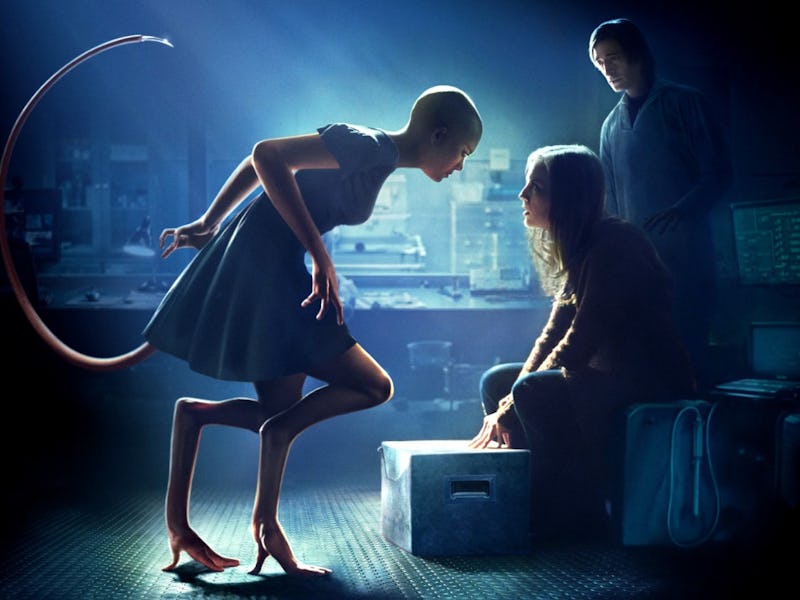Adrien Brody’s Underrated Body Horror Movie Made Parenting Look Terrifying
How far would you go for your child?

Clive (Adrien Brody) and Elsa (Sarah Polley) are experiencing every new parent’s worst fear — their child’s fever won’t go down. A cold bath isn’t helping, they aren’t sure what medicine to give her, and they can’t call a pediatrician for advice. Why? Dren is a “hybrid,” a secret lab experiment created by splicing human and animal DNA. She has amphibious lungs, a poison-tipped tail, and for good measure, retractable wings.
In Splice, two scientists play God with unwavering confidence yet find themselves utterly ill-equipped as parents. Creating life — depicted through rapid-fire montages featuring lines of computer code, test tubes, and DNA models — is easy, but nurturing it? No amount of lab tests can come close to replicating the trials of childcare. The drama doesn’t stint on sci-fi weirdness, featuring sex-swapping creatures and an uncomfortable stretch of interspecies psychosexual tension. But for all its bizarro energy and credulity-stretching science, it’s also surprisingly perceptive about what it takes to be a parent.
Vincenzo Natali’s film frequently blurs the lines between scientist and sentimental parent, right from an opening that initially appears to be a birthing sequence. There’s the usual medical chatter about vitals and blood pressure, the expected cutting of the umbilical cord, and a couple's wide-eyed, loving gaze. “He’s just perfect,” Clive coos. “He’s so cute,” Elsa fawns. When she pulls out her camcorder, it’s easy to assume she means to capture the baby’s first moments.
It’s only through the viewfinder that we finally see what she’s looking at — a pulsating, shapeless flesh sac nestled in Clive’s arms. As this hybrid, Fred, is placed in a glass case with Elsa still recording, it becomes clear the scene is a twisted spin on capturing a baby’s first milestones. The scientists wait to see how Fred will react to another hybrid, Ginger, the way one might nudge their child to make friends at preschool. From the human names to the affectionate way they refer to their test subjects — “Our boy’s growing up to be a fine young man,” says one research assistant — there’s a dangerous degree of emotional bias that creeps into what’s meant to be analytical work.
When Dren is created, Clive comes to work worn out and tired from running tests on her, not unlike a parent whose infant has kept them up all night. There’s frustration at her incessant crying, and triumphant joy when she finally settles into a feeding routine. Like any parents with a newborn, Clive and Elsa’s romantic life takes a hit, and they’re guilty of neglecting their older “children,” Fred and Ginger. When Dren’s unique genetic makeup translates into accelerated aging, it poses fresh problems for the couple. Dren is suddenly a rebellious teenager they can’t parent and a test subject they can’t control. It’s jarring when Elsa calls the infant Dren sweetie because it’s so far from the professional distance a scientist should adopt, but it’s also jarring when she scolds the older Dren for being a “bad girl” because it’s so unlike the maternal posture she’s since adopted.
Every mother thinks their baby is beautiful.
Elsa and Clive slip into their roles as God a lot more comfortably than their roles as parents. Initially, at least, Elsa doesn’t foresee any emotional investment in the creature, instead wanting to create a sustainable embryo for the satisfaction of knowing that she can. She’s resistant to having children because of all the ways her life would have to change, and as if to reinforce her point, the next scene features fetus Dren violently attacking her and inducing a seizure, the film’s spin on the damage childbirth wreaks on women’s bodies. Elsa later rejects Clive’s request to put the creature out of its misery, rationalizing that keeping it alive would allow them to study it further. This dispassionate stance vanishes, however, once she begins to see Dren as a daughter.
Splice roots Elsa’s anxieties about parenting in her own fraught childhood and her cruel, controlling mother. As Elsa slips into familiar patterns, attempting to exert the same control over Dren in the guise of rigid scientific protocol, the film asks if it’s possible to be a good scientist and a good parent. Can reason and rationality override emotional impulses? Can care and compassion inform hard but practical decisions?
The first of the film’s twists illustrates just how much Elsa has blurred the lines between her two identities — Dren’s human DNA isn’t from an anonymous donor as she’d claimed, but her own. The second twist is more horrifying. Dren spontaneously changes sex, then rapes and impregnates Elsa. When she agrees to keep the baby, it’s ostensibly out of a perverse sense of scientific curiosity regarding the potential of an all-new hybrid. But it’s also a second shot at raising a child in an environment of perfect control. At the end of Splice, Elsa is God and mother, the film’s most terrifying hybrid of choice and consequence yet.